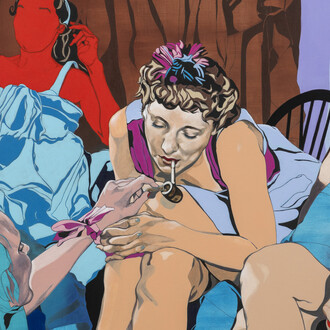This autumn, EYE Filmmuseum is staging a major exhibition of work by two prominent film artists: Apichatpong Weerasethakul and Cao Guimarães. Their celebrated work evokes a world that blends dream, sensory experience and reality.
Both artists are deeply rooted in their respective local contexts. Apichatpong Weerasethakul is a Thai artist whose films, film installations, photos and experimental videos – with an occasional exception – are set in the north-east of Thailand, while the work of Cao Guimarães, born in Minas Gerais in Brazil, is very clearly embedded in his surroundings and in Brazilian culture. Each of these artists explores his immediate personal surroundings and what makes them unique. A central concern of their oeuvres is therefore the locus, the place itself. Much of the power of their work lies in their ability to penetrate deeply into the locale and, at the same time, to imbue it with universal relevance.
The exhibition includes Weerasethakul’s large film installation Primitive, which consists of eight short and slightly longer ‘mini films’ or ‘sketches’ that capture the lives of a number of teenagers in Nabua, a small village in the north-east of Thailand. In the 1960s and 70s, this village was the scene of battle between Thai military forces and local civilians who were accused of being communist or having communist sympathies. In this village ‘full of repressed memories’, Weerasethakul films teenagers who gather to chat, play football and daydream. Just like in all his work, this film demonstrates his attentive eye, his protracted shots, his heightened sensitivity to both natural and artificial light, and his ability to subtly invite viewers to reflect on their own lives and on the deeper layers beneath everyday existence.
Also on display is Fireworks (Archives) (2014), a visually stunning and explosive filmic installation that features night-time imagery of animal sculptures from the Sala Kaew Kuu Temple in northern Thailand. This work demonstrates Weerasethakul’s fascination for ‘capturing’ light. Total darkness interrupted by bright flashes of light not only indicates the thin line between the visible and invisible, knowing and feeling, seeing and dreaming, but also alludes to what film is essentially about: capturing light.
Like Weerasethakul, Guimarães has a keen eye for small occurrences, objects, colours and sounds that normally go unnoticed. The power of Guimarães lies in revealing the casual poetry in the ordinary. His films are populated by minuscule insects, soap bubbles, raindrops, petals falling on the ground, footprints, bits of fluff floating in the air. He is drawn to those places where people live but are often overlooked, people who avoid the predictably structured lives we are expected to live in modern capitalist society. Not only people on the fringes of society, drifters and hermits, but also children who, to him, represent the freedom to live as you want, free of any rules of behaviour and full of uncertainty about how to proceed. Guimarães presents us with alternative ways of living, offering us space to break free from our own structured lives. The exhibition presents several of Guimarães’ works from the last ten years.
The work of Cao Guimarães is situated at the interface between cinema and art. Self-taught, he pays little heed to prevailing conventions and predictable forms of filmmaking. Although documentary by nature, his images seem to float between familiar reality and a world in which the senses enjoy free reign and – just as in the work of Weerasethakul – break free from rational considerations. In that way, Guimarães’ images evoke a world that blends dream, sensual experience and reality.
Accompanying the exhibition are two publications, both designed by Irma Boom in the spirit of the artists’ work and richly illustrated, with essays by Consuelo Lins and Dana Linssen. They are published in collaboration with nai010 publishers in Rotterdam, which is also in charge of international distribution.
















